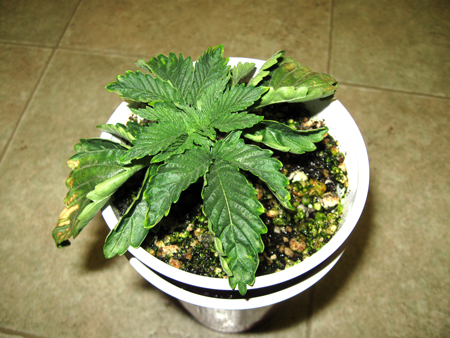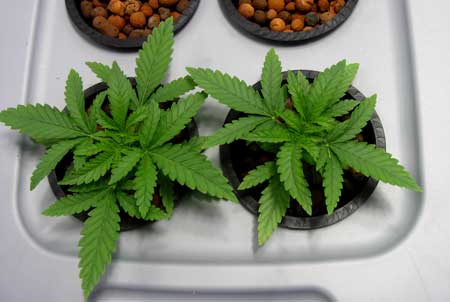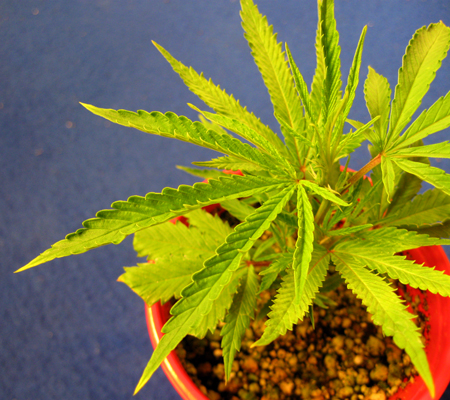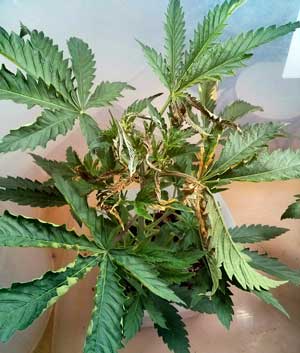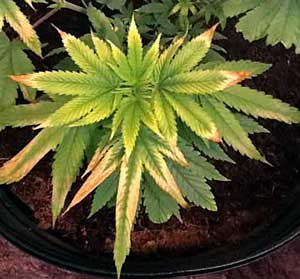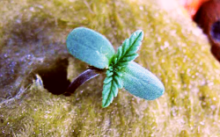You are hereCommon Seedling Problems
Common Seedling Problems
by Nebula Haze
Table of Contents
What Do Healthy Seedlings Look Like?
1.) Overwatering
- Big Pot, Small Seedling
- Small Pot, Big Seedling
- No Drainage (or poor drainage)
- Watering Too Often
2.) Underwatering
4.) Too Much Heat
Before we take a look at cannabis seedling problems, let's show you what a healthy cannabis seedling looks like! If your plants look like this, you're golden!
Healthy Cannabis Seedlings Look Like This!
One last thing before we get into seedling problems; let’s take a look at what healthy seedlings and young plants look like!
Examples of healthy cannabis seedlings
Cannabis seedlings start with two round leaves known as "cotyledons." These leaves are already formed inside the seed and simply open up once the seed has sprouted. After the cotyledons emerge, the "true" (serrated) cannabis leaves will start to grow from the center.
As they get older, the leaves start looking more like the cannabis leaf you are probably most familiar with. Here's what those seedlings look like as they start growing into healthy young cannabis plants...
Now that you know what healthy cannabis plants look like; let's take a look at some common seedling problems to avoid so your plants grow as fast and healthy as possible!
Common Cannabis Seedling Problems
1.) Overwatering - seedling is droopy, growing medium is moist, damping off
When a cannabis plant is "overwatered" it has less to do with the water and more to do with oxygen. Plants can even grow directly in water (hydroponics) but in order to thrive, roots need oxygen. In hydroponics, that's accomplished by dissolving oxygen into the water. But when plants are grown in a container, too much water = not enough oxygen.
When a plant's roots are sitting in water, they quickly use up all the oxygen until the growing medium starts to dry out. Without enough oxygen at the roots, the plant will start showing symptoms. Luckily, there are many steps you can take to prevent overwatering your cannabis plants.
While overwatering can display many different symptoms, most overwatered cannabis plants look droopy, like this...
There's are many different causes of overwatering, and I will cover some of the most common ones here!
When you have a small plant in a very big pot, it’s easy to overwater because the roots aren’t drinking much yet, and the big container takes a long time to dry out.
How to fix:
- (Best) start seedlings in smaller container until they’re growing vigorously, then transfer to a larger container
- if seedling is already in a big container, this is what you can do. When watering, give just a little water at a time in a small circle around seedling. Then allow the top inch to mostly dry before watering again. Once the plant is growing vigorously, start watering as normal (with extra runoff water coming out the bottom every time)
These small plants were put in big pots, and were given enough water to support a much larger plant. The following cannabis plants couldn’t drink all the water that was given to them. As a result, their roots weren’t able to get the oxygen they needed and started "drowning." Once the roots are out of commission, the leaves start drooping.
One way to prevent this from happening is to put plants in the perfectly sized container for each stage of life by transplanting.
So first, you need to get a general idea of the final container size, which will be based on how big you want your plants to grow. The less often you transplant, the bigger the final size pot you'll need because the roots will tend to grow out and cover the whole container if left too long. You can help avoid problems with roots getting rootbound by using a fabric pot (also known as a "Smart Pot") or an air pot.
Final Container for Desired Plant Size - General guide
(the less often you transplant, the bigger final size you'll need)
12" ~ 1-2 gallon container
24" ~ 2-4 gallon container
36" ~ 3-6 gallon container
48" ~ 4-8 gallon container
60" ~ 5-10 gallon container
But what size pot should you use for your seedlings?
For fastest growth rates, it's better to plant young seedlings or clones in a very small container, like a disposable plastic solo cup.
For new seedlings and clones, use a small container if possible
Easy transplant guide - some popular transplant guideline:
- Solo cup -> 1 gal -> 3 gal
- Solo cup -> 1 gal -> 5 gal
- Solo cup -> 2 gal -> 5 gal
- Solo cup -> 1.5 gal -> 3 gal -> 5+ gal
There is no perfect transplant guide, but the one above should give you a general idea of where to start.
Why don’t you want to go from a solo cup to a 5 gallon pot? Or why not just start in a 5 gallon pot?
Young plants are not growing fast yet, and they aren’t using much water. When you completely saturate a big container, the plant won’t be able to drink it all. Since so much of the water is contained in the middle without access to air, it won’t be able to dry out by evaporation. So you’re left with a huge container full of wet potting mix.
The young cannabis plant roots will quickly use up all the available oxygen that's been dissolved in the water, and then the roots will sit in water until the water slowly evaporates on its own. Some containers such as smart pots and air pots allow air in from the sides, which can help dry the growing medium faster, but it’s better to use proper technique from the beginning.
Overpotting Cannabis
Planting in too big a container is sometimes called “overpotting.” It’s possible to get around this with special watering techniques (for example by giving plants just a little bit of water until they start “growing into” their containers) but starting plants in small containers and transplanting as they need it can be a more straightforward way for some growers. Overpotting plants is also a waste of growing medium and nutrients, especially if the plants never get big enough to fully use their containers.
Example
This OG Tahoe Kush seedling was overpotted, though this can be overcome by the grower just giving a little bit of water at a time until the plant starts growing vigorously. At that point, the grower can provide more and more water until they’re finally watering normally.
More information about container size and transplanting here: http://www.growweedeasy.com/germinate#what-size-pot
While too big of a container can cause problems for seedlings, so can too-small of a container.
Seedlings are happy in a small container like a solo cup for a while, but as they get bigger, their roots need more room. The roots tend to wrap around the outsides of the container, encasing the middle part so that water can't get out. This is known as the plant being "root bound."
If the seedling isn't transferred to a bigger container in time, it can cause symptoms of overwatering, nutrient deficiencies, wilting, and sometimes very strange and unpredictable symptoms.
These plants were left in a too-small container for too long. Because they were drinking so fast, the grower watered them frequently - too frequently. This combination of being root bound and overwatering caused the plants to suffer.
Too small container, combined with overwatering - these conditions can causes some strange symptoms that often look like a nutrient deficiency
Pink leaves, red discoloration, rusty spots and edges... While it make look like these cannabis seedlings are experiencing a nutrient deficiencies, all these symptoms are actually caused by overwatering plus a too-small pot.
When the roots aren't happy, the plant isn't able to uptake nutrients properly, and cannabis seedlings can show a wide variety of strange problems.
It's usually not a good sign when cannabis leaves start "crossing their fingers" like this (instead of having all the leaf tips spread out). While this can happen naturally every once in a while, you know for sure that you're having a problem if the crossed fingers are combined with discoloration of the leaves. Also notice how the stems are bright red/pink.
The following cannabis plant was also overwatered and had no drainage. Notice how dark the soil is and the green algae growing all along the top of the soil - these are more signs the plant has been overwatered for quite a while. You should never water your plant when the soil is still wet at the top, and if you notice lots of algae growing on top of your soil, it may be a sign that you're overwatering on a regular basis. Leaving the top of the soil wet is also the number one reason growers get fungus gnats.
No Drainage (or poor drainage)
Cannabis roots need oxygen to thrive, and therefore they will have trouble if the roots are “drowned.” If water cannot run out the bottom of the container, it will sit at the roots, which causes overwatered plants.
How to fix:
- Always start with a good growing medium that drains well - never use a clay based soil which holds onto way too much water. A high quality potting mix (especially mixed with some perlite) provides great drainage
- Start with a smaller container to reduce the chances of overwatering seedlings
- Make sure there are plenty of drainage holes to let water out the bottom of the container
- If water runs through growing medium slowly, you can mix perlite into the potting mix to increase oxygen and quicken drainage
- Water less often and less at a time until plant is drinking more
- Get a container that helps the growing medium dry out from the sides (such as “Smart Pots” - highly recommended; or air pots).
This seedling started "damping off" (dying) due to terrible drainage from bad soil. Never use soil that looks like it contains clay!
Seedling is "damping off" due to bad soil with no drainage
Here's another example of a seedling damping off due to too much water (drowning roots), whis time combined with not enough light. After a few days of these conditions, this seedling just fell over and started dying.
The following plant was grown in an unsuitable growing medium with no drainage and started showing signs of overwatering. Always start with a quality potting mix that has good drainage, and never allow the top of your growing medium to look this wet!
This “soil” is more like mud. The plant roots are drowning from lack of oxygen, causing severe wilting.
As I keep mentioning in this section about overwatering, cannabis roots need oxygen to thrive, and therefore seedlings will start having trouble if the growing medium is never allowed to dry enough to provide a steady supply of oxygen to the roots.
While oxygen is available to the roots immediately after watering, the roots use up all the oxygen quickly if they are sitting in water. If all the oxygen is gone, roots are not able to get what they need to help power growth, at least not until the growing medium begins to dry out and create new air spaces in the growing medium.
Keep roots happy for fast-growing plants
Each air spot in the potting mix provides roots with precious oxygen, but if there’s no air spots, roots start to “drown.” By watering seedlings less often, growers can ensure that roots are getting access to plenty of oxygen at all times.
Of course you should never allow roots to actually dry out - roots need moisture at all times. But for new growers who want to do everything possible for their new seedlings, it can seem like more water = better. This isn’t true.
Roots work best when they get as much oxygen as possible, while making sure roots stay completely moist at all times.
How to Fix:
 Wait until top inch is dry. Make sure that the top bit of potting mix has started to dry before you water seedlings again. Sometimes it can take a few days, depending on your growing medium, your environment and how much water you provided during the last watering.
Wait until top inch is dry. Make sure that the top bit of potting mix has started to dry before you water seedlings again. Sometimes it can take a few days, depending on your growing medium, your environment and how much water you provided during the last watering.- Increase the number of air pockets in the growing medium by mixing in a "lighter" amendment like perlite to the potting mix. Perlite will allow the mix to hold onto more oxygen when mixed with heavy soil. Many cannabis soil growers will mix 30-40% perlite into their potting mix to make sure there's lots of drainage and plenty of air available for the roots.
 Provide air from the sides. Transplant to a container which allows air in from the sides like fabric pots (“Smart Pots” - highly recommended) or air pots.
Provide air from the sides. Transplant to a container which allows air in from the sides like fabric pots (“Smart Pots” - highly recommended) or air pots.- Start in a smaller container until plant gets bigger so there’s less water in the potting mix that needs to dry. You’ll be able to water your plants more often while ensuring they get plenty of oxygen.
- Water less when it's cold. Plant processes tend to slow down when temps get cooler. This means that plants usually need water less often than normal after a cold snap.
This plant went through a few cool days but the grower continued to water as normal. As a result, the plants roots were surrounded by too much water and the plant started showing signs of overwatering.
The plant was watered the right amount each time, but too often. As a result, it shows some slight drooping. While this won’t kill the plant, the plant will definitely grow faster when the mix is allowed to dry out a bit so the roots are getting plenty of oxygen.
2.) Underwatering - seedling is droopy, wilting, or not growing properly, and the growing medium around the seedling isn’t moist
While overwatering is the most common seedling symptom, underwatering is also a problem, especially for those who have been warned to avoid giving too much water.
It can be confusing because the symptoms often look similar to each other, which is why it's important to learn good watering practices.
This seedling was underwatered - the grower had been warned many times to avoid overwatering, and went too far in the other direction. Notice that the growing medium looks bone dry.
It’s crucially important to make sure that plant roots have access to moisture at all times. Plants are constantly losing water through their leaves (called “transpiration”) and this is actually how plants get water up from the roots. As the plants lose water from the leaves, it pulls water up from the ground like a straw.
When there’s not enough water at the roots, many plant processes cease to function. If roots actually dry out, the dried shoots die.
Here's another example of a young cannabis plant that is underwatered, even in a big container (where the problem is usually overwatering). Notice how this cannabis seedling is basically just wilting and falling over, while the potting mix looks completely dry.
Seedlings suffer greatly from being underwatered, even more so than from overwatering. Often the grower will actually be able to see how dry the growing medium is. A big sign that the plant is being under-watered is when you can see the soil separating from the container. In this case, you can see the starter cube separating from the soil because it's so dry.
Underwatering is bad on it's own, but it causes the most problems when young cannabis seedlings are also stressed by too high levels of nutrients, or when started in a “hot” (nutrient-enriched) soil.
When underwatering is combined with too much nutrients, seedlings often become dark green and stunted, with twisted and discolored new growth.
The solution for this (underwatering + high levels of nutrients) is simply to give the plants more water so they can establish roots and start growing again. Most plants will be able to grow out of this problem once they get enough water to start growing. While it’s not always the best idea to start out with a hot soil mix, most seedlings will easily grow into it if given a good growing environment.
This cannabis seedling is dark because it was underwatered in a "hot" soil mix, but after watering the plant as normal for a week or two, the plant started growing vigorously
3.) Nutrient Problems - leaves are yellow, discolored, crispy or have spots
Healthy cannabis leaves on seedlings should be green! Again, here's what healthy leaves look like...
Healthy Leaves Look Like This
When the cannabis leaves of young plants stop being green, you need to react. Changes of color (such as yellowing, spots, burnt tips, etc) are usually a sign that there's a problem when it comes to young cannabis plants.
The leaves of young cannabis plants & seedlings should be green!
Some common seedling nutrient problems include...
A nutrient toxicity is most common in dry or hot conditions, when starting in "hot" soil, and when plants are underwatered.
Two of the most common signs of nutrient toxicty are tip burn and dark leaves.
Tip burn is a sure sign that the plant took up too much nutrients
A closeup of nutrient tip burn
Nutrient burned tips eventually start curling upwards if nutrient levels are too high for too long
Very dark leaves often indicate a nitrogen toxicity (too much nitrogen)
If a nitrogen toxicity is left too long, it starts causing other nutrient problems, like the yellow lines on the bottom leaves of this plant.
Causes of Nutrient Toxicity
- "Hot" Potting Mix - Sometimes seedlings get a nutrient toxicity when started ing a “hot” potting mix (one that has a lot of nutrients). If it’s good soil and you're watering properly, your seedlings will be able to grow out of this relatively quickly.
- Slow-Release Soil - Nutrient toxicities are common when grower start with a “extended release” soil like Miracle-Gro original soil - you don’t want any type of soil that will be slowly releasing nitrogen throughout the grow; it will cause nutrient burn and reduced bud development in the flowering stage. Avoid original Miracle-Gro soil and any other slow-release soils!
- Give Nutrients Too Soon - Giving nutrients too early will overload the seedling with nutrients - in a good soil potting mix, additional nutrients usually aren't needed for the first few weeks at least
- Give Too Much Nutrients At Once - Giving too much nutrients at once can cause a toxicity overnight - always start at half the recommended dose according to the nutrient schedule (most cannabis nutrients come with a nutrient schedule), and see how your plants react before upping the dose
Too much nutrients too soon caused this (tip burn)
While the above seedling may look light colored, the problem is actually that it was given too high levels of nutrients.
When there's too many nutrients, the plant can start getting light colored because some nutrients are getting locked out. The tip burn on the leaves is a good indicator that this problem is caused by too many nutrients. Also this grower started with a "hot" (nutrient rich) soil mix, and there's no way a plant this size could have already used up all those nutrients.
A lot of growers may think the way to fix this is add more nutrients since the plant leaves are pale, but that will actually make things worse! This plant just needs some plain water until it starts to use up the nutrients in the soil, and it will soon take on a healthy green appearance on new leaves.
Not Enough or Wrong Kind of Nutrients
Nutrient deficiencies and other nutrient problems are most common when growers are using the wrong type of potting mix or cannabis nutrients.
Two of the most common signs of nutrient deficiencies are pale or yellowing leaves and other unusual leaf discoloration.
The most common type of deficiency is a nitrogen deficiency.
The yellow leaves of a nitrogen deficiency may show signs of brown, and they will usually become soft and sort of "fold" in, before turning crispy and falling off on their own.
If the yellowing leaves are at the top of your plant or the yellow leaves are mosty new growth, then you probably don't have a nitrogen deficiency. Nitrogen deficiencies affect the oldest, lowest leaves first.
Nitrogen Deficiency Leaf Closeup
There are many other nutrient deficiencies, and you can view them all here...
Look at more nutrient deficiencies!
http://www.growweedeasy.com/marijuana-symptoms-pictures
Causes of Nutrient Deficiencies and Problems
- Soilless Medium w/o Hydro Nutrients - Some growers may start in a soilless medium and not realize it has no nutrients (with a soilless medium like vermiculite, coco coir, pertlie, rockwool, etc, it’s up to the grower to provide all the nutrients since they are inert mediums and don’t contain any nutrients on their own) which results in a deficiency if grower isn't providing extra nutrients. Soilless mediums are easy to grow in, but they do require the grower provide nutrients from the beginning.
- Don't Provide Nutrients As Plant Uses Up Soil - Many growers start in a good soil that has nutrients, but don’t give nutrients or transplant seedlings to a bigger container when the plant has started to use up the nutrients in the soil
- Wrong Type of Nutrients - Nutrient deficiencies commonly show up with the grower gives their plants the the wrong type of nutrients - generally it’s a good idea to give a “vegetative” nutrient formula for the first part of the plant’s life and a “bloom” nutrient formula for the flowering/budding stage. When giving the wrong time of nutrients at the wrong time, your plant won't grow as well. If you give vegetative nutrients in the flowering stage, you make it harder for the plant to form buds, while also increasing the chance of getting nutrient burn and other nutrient problems.
- Not Maintaining pH - If growers don’t manage pH, their plants may show signs of nutrient deficiencies even if the nutrients are actually there near the roots.
- Improper Watering Technique - Growers who don’t water properly (growing mediums stays wet or dry for too long, poor drainage, etc) often start getting nutrient deficiencies as the plant isn't able to effectively carry out normal plant processes
- Too Small Container - Nutrient problems crop up when plants are kept in a small container for too long without being transferred to a bigger pot (this is known as being "root bound" and can cause the plant to display nutrient deficiencies because the roots aren't functioning properly)
- Bugs - a lot of bugs and pests may initially look like a deficiency (spots on the leaves can appear from bites, or if bugs have infested the soil, etc)
4.) Heat - leaves bend in the middle so they look like canoes or tacos, turning up at the edges, wilting, strange spotting, symptoms usually appear after temperature starts climbing.
When the heat gets too high, the edges of the leaves will begin to curl up and the leaves will begin to "cup" or "taco."
Here's another cannabis seedling suffering from heat stress - notice how the edges are curling upwards. The solution to this problem is simply to lower the heat as experienced by the plant.
Sometimes the leaves sort of fold downwards due to heat, too, like this seedling
After being subjected to overwatering plus a heat wave, the leaves of the following seedling started cuppping upwards and turned lime green. The stems and veins of the leaves were turning red. You can see the soil is still dark and wet because the plant stopped drinking after developing root problems.
Cannabis plants often display heat stress when grown in hot, dry weather, especially when not given the right amount of water.
Learn more about cannabis heat stress and how to fix it: http://www.growweedeasy.com/heat-light-stress
5.) Not enough (or too much) light - burned or crinkled leaves, too much space between nodes, tall seedlings that fall over
Not Enough Light = Stretched, “Leggy,” Tall Seedlings
Too Much Light = Burned, Crinkled Leaves
Stretched, “Leggy,” Tall Seedlings - Give More Light!
This seedling is stretching too tall, with a lot of space in between sets of leaves, and a long thin stalk. This is caused by the plant not getting enough light. It’s “reaching” upwards, trying to find the sun.
More seedlings stretching from lack of light
To fix too-tall seedlings, simply provide more light (usually by bringing grow lights closer or getting a brighter grow light)
After giving enough light, growers can bury the extra stem, or just wait until the seedling grows out of it on its own
Burned, Crinkled Leaves - Reduce Light or Move Grow Lights Up
This cannabis seedling basically grew up into the grow light!
This cannabis seedling is being burned by too-close LED grow lights
FAQs - Frequently Asked Questions
Question: What do seedlings like?
Answer: Moist but not drowning conditions, warmer temps, and a bit of light to help them start growing. Very little nutrients to start.
Question: How do I avoid germination problems?
Answer: Before anyone worries about cannabis seedling problems, it’s important to get your cannabis seeds to sprout!
So make sure you are avoiding these common germination problems!
Most importantly, just remember that cannabis seeds like a warm, moist environment to sprout.
Common Germination problems
- Too wet - don’t drown your seeds! While it’s okay to soak seeds for the first 24 hours, after that they should be moist but not soaking.
- Too dry - if seeds are too dry, they won’t sprout! If seeds sprout but then are exposed to dryness, they will die.
- Too deep - if you plant seeds too deep in the growing medium, they may have a hard time making it to the surface. An inch deep (just enough to support the seed and cover it) is about as deep as you’ll ever need to go.
- Not warm enough - seeds and seedlings like warmer temps (from 80-85 F) and will grow more slowly in cooler environments.
- Wrong starting growing medium - Many growers like to plant their seeds directly in a growing medium, just like in nature. But some growing mediums are better for seeds than others. Learn more about the pros and cons of different starting growing mediums here.
- Old or improperly stored seeds - any seeds that germinates is a good seeds, but older or improperly stored seeds often take longer to sprout, and may no sprout at all, even if you do everything right.
- Not ripe seeds (pale or translucent) - while any seed that sprouts is a good seed, seeds that are pale, flimsy or translucent have very low germination rates because they’re not fully mature.
- Too much humidity - Some growers like to use a humidity dome for new seedlings, but don’t leaves these on too long after sprouting, as too much humidity can cause “damping off (seedling sort of folding over and dying, more info below)
Learn more about germinating cannabis seeds!
http://www.growweedeasy.com/germinate
Question: Am I drowning my plants? I planted my seeds two days ago in moist soil, I watered them a little, but no waterlogging. I then stopped watering them for fear of drowning them. Today, the top of the soil is getting dry, there's still some moisture left in it, but not much from what I can tell. Should I keep it moist or just leave it be?
Answer: Young seedlings can get easily drowned, especially in a big container. But at the same time, they like moist conditions, and seedling roots should NEVER dry out as this can kill or seriously stunt your plant.
But how to balance the need for both water and air?
In a smaller container like a solo cup, it’s very difficult to overwater young seedlings as long as there’s plenty of drainage and you’re using a good growing medium. Once seedlings have started to outgrow a small container, you can transfer to a bigger container and the seedling will be much more robust.
If you’ve started your seedling in a big container, it’s good to be worried about overwatering young seedlings. In a large container, it generally takes a relatively long time for the growing medium to dry out, and your seedlings aren’t drinking much. Therefore it’s easy for them to get waterlogged. In this situation, you can use a spray bottle or a mister to mist the area around the plant thoroughly, which will seep down to the roots and keep them wet, but won’t soak the soil. Another option is to use just a small amount of water, maybe a cup at a time, and water in a circle around your plant until it starts growing vigorously. Giving seedlings just a bit of water at a time prevents them from getting drowned in drenched soil.
Once the plant is growing fast, you can start watering as normal (water until 20% runoff comes out the bottom, then don’t water again until the top inch is dry to the touch). At this point your plant will be drinking more and will have a stronger root system to seek out both the water and the oxygen it needs.
After reading this article, all your seedlings will look as green and happy as this one!
Jump to...
How to germinate cannabis seeds
Teach me the basics of growing
















